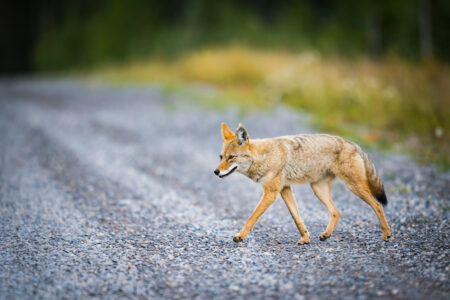One reader reflects on the pros and cons of letting small-livestock predators co-exist with homestead animals, including ways to predator-proof your homestead.
It’s absolutely inevitable. At some point on your homesteading journey, you’re going to encounter a predator. But we’re often tasked with that age old question – do you kill the predator or “let nature take its course” and just try to perfect your security?
Maybe you’ve never asked that question and simply go on the “kill it” war path because that’s just what seems most common and advised. Or maybe you haven’t yet had to deal with predators and your farm is built like Fort Knox. (Good for you!) Either way, there’s really no right or wrong answer (unless it’s against the law). But here are a few things to consider before grabbing that gun without second guessing.
I want to stress that this blog post is about small livestock (chickens, rabbits, etc), not larger livestock. Though it could be applied to both. Often, the larger the livestock, the more your livelihood depends on the safety of your animals. This may mean that you encounter larger predators in larger quantities (coyote/wolf and bear, for example), in which case, it’s extremely understandable that you must take matters into your own hands when necessary.
When we first got chickens, I was extremely protective. Anything that even remotely looked the wrong way while passing by the coop was automatically labeled as a potential predator. I remember watching a raccoon trying to climb over the chicken run last summer, and I immediately grabbed the gun and headed out the door. She scampered off before I ever got a shot in. I came to learn, weeks later, that she had a very hungry litter of babies she was trying to feed, and then it hit me…
Why am I trying to kill an animal that is simply doing its job – feeding its family and providing for itself?
It didn’t seem fair or logical to me. But at the same time, I didn’t want this predator getting my chickens either.
Fast forwarding to this winter. We had such a rough winter here. Snow upon snow upon ice and rain. It was wet and nasty. We lost a lot of chickens this year. During our chicken adventure, we had only ever lost one chicken the entire time we’ve had chickens. This winter was horrendous. I was shocked and devastated. I was angry and felt entitled to kill the hawks, falcons, and eagles that were picking off our chickens. But fortunately for them, it’s illegal in the state of Virginia to shoot, trap, or kill a bird of prey. This meant that I was forced to find alternative routes to ensure my small livestock’s safety.
I had fellow chicken keepers mad at me because we free range.
I had fellow homesteaders telling me that it was “just nature doing its thing.”
I had other people telling me I was a horrible person for sitting there and not shooting it — they “didn’t care whether it was illegal or not.”
But sadly, the very same people that were screaming at me because I allow my chickens to free range are the very same people who would shoot shoot shoot if a predator came their way. But they wouldn’t shoot a hawk…because it’s illegal.
If that’s the case, shouldn’t that tell you something about our ecosystem?
It is fragile. Animals are on the verge of extinction because of our selfish ambitions, as good as they may seem at the time.
I remember a video of some sweet farmers (Heritage Hollow Farms) that live right up the road from me. Farming is their livelihood. They 100 percent depend on their income from their farm to live. And what I witnessed was an incredible act of humankind — compassion, grace, and realizing the fact that they (predators) were here long before we ever were. And while that doesn’t give us the excuse to throw our livestock into their mouths, it does give us a reason to stop and think about their lives.
Click here to view the coyote video.
And here is what Molly wrote to go along with the video:
“This morning Mike came across a sight no farmer wants to see: a very large & healthy coyote stuck in your fence with your sheep on the other side. All sheep accounted for. Returned to the farm and came back with a rifle and wire cutters. This is a tough choice for one who knows this very same coyote could come back and have one’s sheep for dinner. The other concern is the quality of life for the animal if the wire has caused bodily harm if he does get loose – would he be OK or have a slow, in-humane death? We fully realized the safety issue and farmers & ranchers have been battling predators for hundreds of years. Our border collie was loose all last night in those fields after fleeing a kick to the head from a steer – that coyote could have gotten to him.
With this situation in particular, we assessed the wire best we could and deemed it likely he could get it off himself once loose (he was choking with each thrash) – It was not barbed wire. I was armed with the rifle and we agreed we would give cutting the wire one chance. If it didn’t work or if he showed any signs of aggression we would use the rifle.
You see, yes, the easy solution and some will say the best, was to just finish him off. To me, that is the fear talking over grace and heart-based. The Earth needs predators of the animal kingdom to maintain balance – to maintain harmony of the cycles of life. This coyote knew our intentions. There were no growls, no biting – once he was loose we stepped away and he laid there watching us for a couple of minutes before running off and pausing twice to look back at us.
Adrenaline was present, sure, but so was a feeling of peace. A mutual respect for each other: predator & prey. He may not be so lucky, we may not be so lucky if there is a next time. The decision wasn’t made by past interactions with his species, it wasn’t made by possible future interactions (yes, we have lost sheep to them before – perhaps even this same coyote). The decision was made in the present. Perhaps we earned some coyote karma at the farm with this one.”
Molly wanted me to tell you all that they have not lost a single one of their livestock to a coyote since this encounter. She would like to think it’s the good coyote-karma working!
She says it the best, though – we allow fear and annoyance to make our decisions for us more often than grace and heart. Sure, I don’t have a lot of love for animals that kill my small livestock, but I do have a lot of love for all-natural living and homesteading. And I would be a complete hypocrite if I sat here and told you to kill an animal that is part of a system that has been perfected for thousands of years and could survive without man in it – nature.
You see, I realized something profound. I am not an advocate for sustainability if I cannot even support the world of sustainability as a whole. If I am trying to get back to a simpler way of living and being completely self-sufficient, then why is it fair for me to have to kill a predator, who has been doing this a lot longer than I have, just so I can live the life I want?
Let’s not be confused here – there is a difference in killing animals for sustenance. When humanely killing an animal to provide for your family (or in self-defense), there is absolutely nothing wrong with that. There is a sacredness about it that is unexplained unless you’ve lived it.
I say all of this, but I want you to understand that I understand when there is a need to kill a predator.
In many cases, it is just a fact of being a homesteader. Sometimes, you just have to do the hard stuff. But not all of the time, and not as your first option.
Here are the things we do first, before pondering the “kill the predator” option.
Re-enforce fencing, runs, and cages. Bury your chicken run wire. Put an extra layer of hardware cloth. Switch to chain link fencing. Add bird netting to your run if possible. Whatever it is you do, make sure predators can’t get in (from top to bottom).
Invest in nite-guard or automatic lighting options that come on when a predator is lurking (motion sensitive).
Invest in an automatic door opener/closer for your coops and runs. It can either be time sensitive or closed at the push of a button.
Deter birds of prey. We’ve found it easy to deter birds of prey by hanging CDs or reflective aluminum foil pie pans near the chicken run and coop (or the areas where they free range, in the trees). Ever since making these changes, we have had zero hawk/eagle attacks.

Invest in a Livestock Guardian Dog. We do not currently have the space for a LGD, but we will one day! There are many LGD rescues or farmers willing to adopt out their unexpected LGD litters. Do your research first!
Humanely trap the predator and take it to a wildlife conservation area.
As a last resort, when all else fails, killing the predator is certainly an option, and you won’t be judged for it here by any means. Sometimes, no matter what you do, nature truly does show you just how incredible its food chain can be. But we try our hardest to do whatever we can to help keep our livestock safe without altering the course of nature.
We must remember, as homesteaders, it is our job to care for the land — and whether we like it or not, that means the creatures that were here long before we ever decided to call this piece of property our “home”. In most cases, it is not the predators fault that it has gotten to our small livestock — it is our own fault for assuming that we can fool nature into keeping its nose out of our business.
In Genesis God tells us to serve and preserve the land that He has placed into our care. And we have decided to do that here — whether it’s a chicken, a rabbit, gardening, planting, or yes…even giving that predator a second or third chance.
All MOTHER EARTH NEWS community bloggers have agreed to follow our Blogging Best Practices, and they are responsible for the accuracy of their posts. To learn more about the author of this post, click on the byline link at the top of the page.







